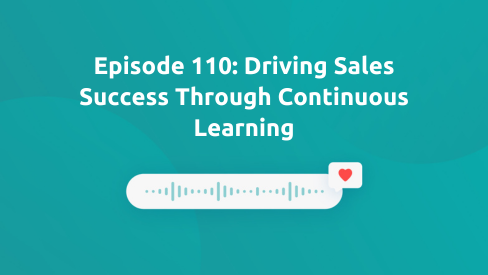Research from The Harvard Business Review suggests 60-70% of all the change initiatives undertaken in organizations fail. In the current economic climate where change is a must, how can organizations navigate change effectively?
Shawnna Sumaoang: Hi and welcome to the Win Win Podcast. I’m your host, Shawnna Sumaoang. Join us as we dive into changing trends in the workplace and how to navigate them successfully. Here to discuss this topic is Lisa Anderson, the Head of People & Organizational Development at Highspot. Thanks for joining Lisa! I’d love for you to tell us about yourself, your background, and your role here at Highspot.
Lisa Anderson: Thank you, Shawnna. I’m really happy to be here. This is actually one of my favorite topics. As you said, I’m the Head of People & Organizational Development, and my team is responsible for talent enablement, organizational development, or OD as it’s known, and learning and development for individual contributors, managers, and leaders.
I think of the team as force multipliers. I personally get a lot of joy from enabling people to utilize their skills and talents so they can thrive and contribute to something bigger than themselves. My expertise lies in the areas that I’m fortunate enough to work on here at Highspot, OD, talent management, organizational design, change management, executive coaching, and leadership development. Most of my career has been spent in Fortune 500 companies, including Dell and formerly EMC and Microsoft doing work that focuses on developing people and creating cultures that maximize their success and business results.
SS: I’m excited to have you here, Lisa, and having been a recipient of many of your programs at Highspot, I have to say, you put together phenomenal programs. On LinkedIn, you actually share that you center a lot of your HR work to align with the company’s business strategy, however, you also want to make sure that you’re fostering environments for people to do great work. How do you approach the business strategy and the objectives with a people-first approach?
LA: I strongly believe in the power of strategic HR to positively impact business results and employee experiences, and I think that great culture and business results can coexist and should coexist. We are here to create a successful business. That’s why people have joined Highspot and I believe that starts with empowering employees and creating a great culture where people want to stay and can grow and leverage their skills and talents and do their best work.
It’s not just me. There’s plenty of research that supports that. My own personal philosophy is that most people want to do great work and use their unique skills and talents, and so I think it’s our job, HR, leaders and managers, to ensure that we’re maximizing the potential of our employees and aligning their work to company goals and strategy.
SS: I love that. Now I want to talk about the topic at hand, which is really focused on this change management component. Can you tell us what change management means from an organizational development perspective?
LA: Change management from an organizational development perspective means that there’s a planned approach in place to guide the organization to achieve the goals of the change. So why is that important? Well, you mentioned it early, the HBR statistics about the failure of change initiatives. It’s pretty startling and so I think that if a company is going to make a decision to make a change, then you want to achieve the goals of that change, but change, regardless of the kind of goal, can be really disruptive to a business and to employees.
The purpose of change management is to support the company and the employees to achieve that desired outcome. Basically, you want to do what you can to minimize the disruption of change to get to that goal.
SS: Absolutely. So to ask maybe one of the harder questions of today, why is change management often necessary, especially in the current economic climate?
LA: Yes, you’re right and it is always necessary. I think it’s especially important now because this economic climate has turned up the dial on the need for businesses to be effective and efficient. It’s always important, but especially important now and with any large change there’s a dip in productivity as people react to the change they have their own internal reaction to it, and as they land on their feet and figure out what it means for them. This dip in productivity is predictable. The importance of change management is that it can minimize the depth of the dip and the duration of the dip, and that’s ultimately what we want to do. We want to make it as the least disruptive as possible.
SS: Absolutely. What advice do you have for organizations to prepare employees on how to navigate change, and in particular, for our enablement audience, how can training programs help here?
LA: Training helps people become more conscious of their reactions to change. Different people have different reactions, and I think most of us want to say, oh, I love change, I’m great with change, but you know, humans really are not wired like that. We don’t go through it that elegantly, so learning about your own reaction and what trips you up is really helpful, so you can be conscious and just help yourself through it.
Training also helps to ensure that employees know what’s expected. That’s really important. When a change is implemented, do people understand what the new processes are? Maybe it’s a new way of working, or maybe roles and responsibilities are changed, so making sure that people know what the processes are and they know how to use new tools, do they know how their work has changed and who they’ll be working with? There may be handoffs or dependencies that are different. Those are really important things that can be addressed in training.
Another thing that’s important is knowing how key decisions will be made, and that means who will be involved in the decision and ultimately who makes it. One of the biggest areas that have been impacted the most by change is clarity when it comes to decision-making. That’s one that I really like to invest in. Let’s say you are an organization and you’re going to have a reorg, but you know that you have either a big release coming up or you have an event coming up. To take people through that change and talk through what might that look like and work through the details before it’s actual life is really helpful.
SS: I love that as a best practice. On that note, we’re actually focusing thematically on what good looks like, so I’d love to get your perspective. What would you say that good training looks like when it comes to navigating change?
LA: I would say clarity regarding goals, roles, and processes is the number one thing. It’s really easy after a change for there to be discord afterward, conflict with people, and usually, it has to do with either roles, goals, or processes being unclear. That’s a really important place to start and, as well, when we talk about goals, not only what are the company goals and what are the team goals, but what are my goals and how did they align?
Dan Pink talks about intrinsic motivators, autonomy, mastery, and purpose. People want to contribute to something bigger than them, and so that’s why it’s important to really make sure that people understand how their goals are aligned. Then, what is my role and who do I work with? I talked a little bit about that and clarified the handoffs. I talked about that a bit about the processes, so I used to work with one person and now I’m going to work with someone else.
You want to get ahead of any issues so you can identify if there are gaps or there are overlaps. I’m doing steps A, B, and C, and you’re doing D, E, F, and the person you work with says, oh, I thought I was doing C, or none of us are doing C. In training, you can have those kinds of conversations, and get ahead of it before it actually happens.
Good training also is an opportunity for leaders to share the reasons for the change. It’s not just the tactical, but what does my job look like and who do I work with, but to pop up to the big why and have people feel inspired because it’s working to go through a change and you want people to be invested and see what’s possible for them. Having a North Star is really important for motivation and buy-in, so that’s another thing to do in good training.
I would say as a result of what I’ve just shared, good training would be a combination of skill building and scenario planning to provide and understand some frameworks that people can leverage and then apply those frameworks to an opportunity that’s coming up like I was saying, a release or an event so groups of people can get tactical about what their world might look like as a result of the change. I call that running water through the pipes. Ideally, you would do that with people that you work with, so you could talk through it before you’re in the thick of it.
SS: I love those best practices. I want to drill in a little bit because you talked about the importance of motivation and I think when times are tough, keeping up with quota while adjusting to change can be really challenging for sales reps. How can enablement leaders and sales leaders motivate sales reps and really ease the process of change?
LA: Well, I do think for any change, but especially for folks who have a quota to meet, the leader’s job in change is to clarify the purpose of the change and paint a compelling picture of what’s possible as a result of the change. Then have really active two-way communication. That’s important because it’s not only so leaders can communicate changes, but then reps can communicate what’s working, what needs to be adjusted, and where they need more information or context, or support.
In the situation of introducing a new tool, let’s say, it’s really important that leaders get that information quickly about whether this tool is not doing what we thought it was going to do, or this tool needs to be tweaked a little bit, whatever it is. Having that two-way dialogue is very important.
Another thing leaders can do is facilitate peer-to-peer learning. Get people in a room who do the same or similar job and help have them help each other. It’s a really underutilized but very effective way to learn peer-to-peer learning, and it gives people opportunities to learn and it also gives people opportunities to shine. That’s another thing that leaders can do.
I think the bottom line is leaders need to ensure that people know what’s expected of them. They need to eliminate any barriers and ensure people have the appropriate tools. I would say that people want to have challenging jobs, but not challenging them for the wrong reasons. Not this thing that should take me 15 minutes is taking me 45 minutes as an example, so I think those are some of the things that leaders can do to motivate sales reps and ease the process of change.
SS: Fantastic advice. Now, I know, especially at Highspot, we like to take a data-informed approach. I’d love to learn from you, what are some metrics you recommend tracking when driving change and how can Highspot maybe even help with this?
LA: I’m a big fan of taking a data-informed approach, and I think it’s important to have quantitative data and not to disregard qualitative data. Feedback is valuable from folks within the organizational system to find out what’s landing and what needs modifying. Certainly something like a short pulse survey that you could launch a couple of months or a couple of weeks after some changes have been implemented. Those are great because they help leaders understand what’s working and where a course correction is needed.
I think in terms of how Highspot can help, our Training and Coaching courses are a great opportunity to test knowledge of new processes. At the beginning when you roll something out and then a couple of weeks or a couple of months into it to see what people know, not from a punitive perspective, but as a guide to know where we need to continue to invest in our education. Then, of course, one of the things that we are known for, which is so great, is using Highspot to track usage of the enablement process guidelines and other related documentation to see we have this information, not only are people using it, but also is it hitting the mark. So do we need to create something shorter? Do we need to create something with more context? Do we need a video? There are lots of ways that Highspot can help track changes and help people to track changes.
SS: Fantastic. Last question for you, Lisa. This has been phenomenal. Can you share advice on making a change stick?
LA: I think making people stakeholders in the change makes it stick. Change is not something that happens to people, but change is something that they are a part of creating. If people have a sense of ownership, it will land in a completely different way. Rewarding behavior change and enabling people to have quick wins in a new way and making change an opportunity to learn and share information, meaning it’s not a one-and-done thing, but there’s an iterative approach to checking in, adapting, checking in, adapting, sharing information, and then being really clear about what the goals are and making that compelling so everyone understands the why. Change isn’t necessarily easy, but really making that North Star compelling so people are willing to go through the process and reap the rewards and enjoy the celebration of the destination.
SS: Lisa, thank you so much for sharing best practices around change management with our audience. I really appreciate your time and your thought leadership.
LA: My pleasure. It’s a fun topic for me to talk about.
SS: Thank you for listening to this episode of the Win Win podcast. Be sure to tune in next time for more insights on how you can maximize enablement success with Highspot.


